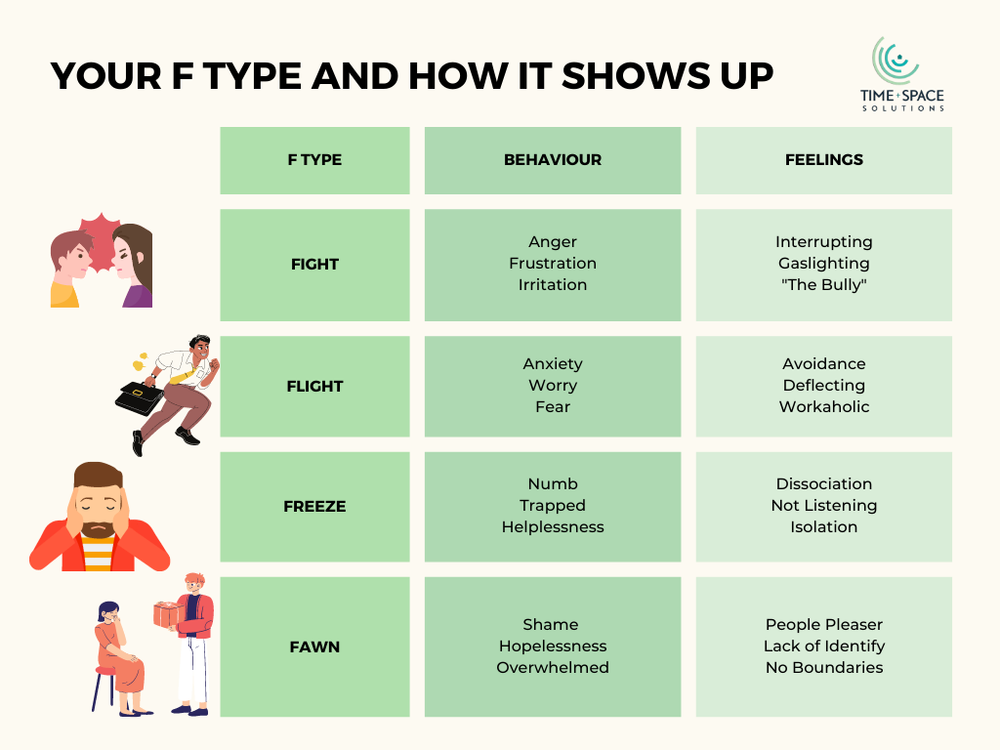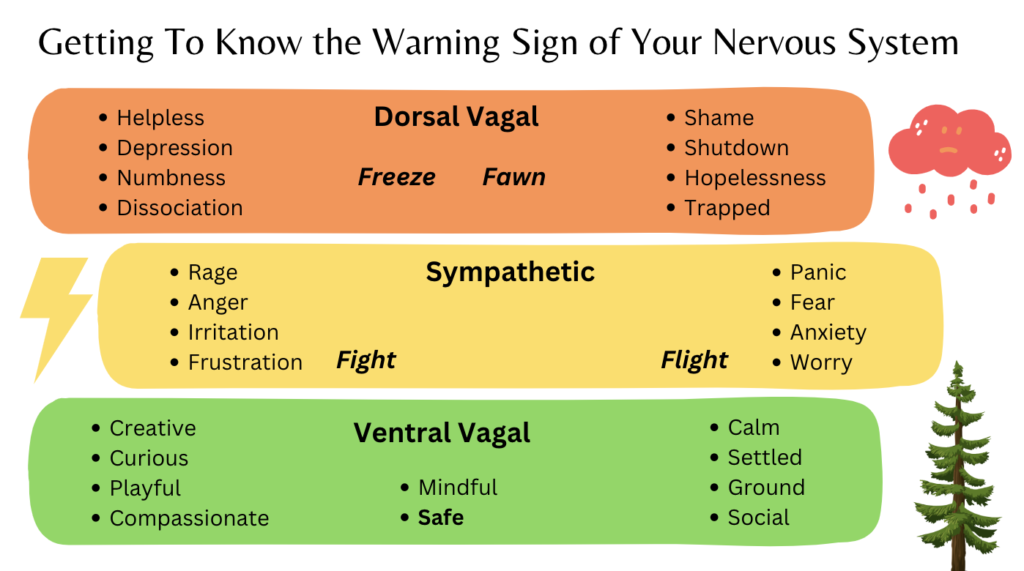For many years I heard about being in fight or flight mode or being triggered and brought outside of my nervous system window. I learned that there are more than those two states we can go into when we perceive that we are unsafe. These states are now known as “f types”: fight, flight, freeze, and fawn. These f types play a role in how we think, feel, behave and what we believe. Most of us have a dominant f type, or a preferred way to react when we think we are in danger. But depending on the context of a situation you may cycle through all of the f types before returning to ventral vagal (the ideal state for your nervous system). When experiencing a “f type” we cannot think clearly or act from a place of consciousness.

What does this have to do with life clutter? TONS! In my work decluttering with people over the last nine years, I noticed that most of the time that their clutter is caused because they are reacting from a place of fight, flight, freeze or fawn. It’s those reactions that become habits, they have a story connected to them which began from a challenging or traumatizing experience. In order to cope with that experience your nervous systems went into protective mode and you developed a way to feel safe. Most of us cycle through the same reactions over and over without ever stopping to ask questions or examining if those reactions serve us or are necessary anymore.
Your F Type and your Nervous System
Our nervous system has an innate automatic response that allows us to react in four different ways. It’s what keeps us safe, aware of a threat and judges our ability to respond to danger. When you are outside of your window of tolerance and your nervous system is on alert for perceived danger you will move into an f type. Your nervous window is your ability to deal with stress without going into sympathetic (fight or flight) or dorsal (freeze or fawn). Being able to know when you are in these states is the first step to stopping your reactionary cycle and finding better ways to respond that don’t create life clutter.
The 4 f types:
Flight: You see a perceived threat and flee or go into hyperactivity or seek distractions.
Fight: You suddenly respond aggressively to something threatening.
Freeze: You feel helpless so you numb out, disassociate or collapse.
Fawn: You respond to threat by trying to please or help in order to appease the attacker at the cost of your own needs.
These can also be defined in how we feel and how we behave in the diagram below. Each is a piece of information for us to see how our reactions to feeling unsafe create our clutter.
When we are triggered by situations consistently we can slip into one of the f types regularly. For example, many of us live a stressful life of working long hours, are always on the go and never sit still long enough to know how we actually feel. Living in this activated state and being stuck in flight, as noted in the example above, means that you have not completed the cycle to get back into ventral vagal. It all starts with a trigger (ie. situation, environment) that pulls you out of ventral vagal where the nervous system is perceiving the situation as a threat. If you are not aware of the state you are in, don’t have daily activities or strong habits that automatically get you back into ventral vagal you are unable to calm your nervous system. This ongoing activation causes illness through chronic stress and as a result reactionary behaviors that create clutter, chaos and overwhelm in your life.
Getting to know the different f types, what it looks like when you are outside of ventral vagal and connecting it to past trauma or challenging experiences will help you gain clarity and clear your life clutter.
For example, if you tend to be in flight mode, most likely you often start a task and don’t finish, everything from folding clothes to finishing up tidying the kitchen. What is the trigger that pulls you away from that task? Is there an overall sense of anxiety making it hard for you to stay still long enough to finish something? Does this task remind you of a previous experience where you were unsafe so you want to avoid those feelings and emotions? Asking yourself these questions when you are calm and supported is a great way to get some clarity on your reactions and clutter.
Trigger vs Flashback
I want to take a pause here and note that one, the information I’m providing is very brief. This is a huge topic and my intention is to get you familiar with your f type and to start noticing when you are out of ventral vaga. To learn more I highly recommend this article on the nervous system and what happens to your body and mind. Pete Walkers book “Complex PTSD From Surviving to Thriving” has great info on the f types as well as how to better understand trauma and tools to overcome it.
I want to explain the difference between a trigger and a flashback. A trigger is the initial situation, environment, or action that causes your body to set off an alarm because it’s similar to a past trauma. The state the body goes in, the emotions, thoughts, feelings and the story you tell yourself are the flashbacks. The flashback makes you feel like you are in the past and often you may not even realize this. You may or may not have a story around it, it can just be a sensation in your body and a feeling. It’s like pushing a button to start a machine. What the machine does is the flashback.
This can last moments or up to weeks. It is here that we act from a place outside of ventral vagal and switch into a f type” that comes with feelings, behaviors and beliefs that have become ingrained in us. These ingrained patterns are coping mechanisms that are specific to us and developed when we originally had the traumatic or challenging experience.
Getting To Know Your “F Types” And The Clutter They Create
Regardless of what f types you are in, I’ve noticed when working with clients they all have difficulty making a realistic plan, they feel overwhelmed and a sense of shame. In some way there is a sense of holding onto a belief, items, a way of completing a task and a resistance to change. Use the table below to help you identify what state you are in, how you feel and how it might show up in your day to day life.


Understanding Your Nervous System
Below is a diagram that can help you visualize these states and the emotions that come up for each. Think of it as a traffic light. Green you are good, yellow is a warning sign to pay attention and take action, red means you’ve stopped and really need to address the issue.

Supporting Your Nervous System To Stop Your Clutter Creating Cycle
Staying connected to your ventral vagal means you feel grounded, centered, connected to yourself and others. Find ways to strengthen this state and understand the root cause by widening your window of tolerance through different daily practices, activities and exercises. I created the process below to help you get started as well as a list of daily practices to help you strengthen your nervous system.
- Becoming aware that you are outside of your nervous system window.
- How does it feel in your body? Ie. racing heart, tight stomach
- What is a red flag for you to signal you when you are outside of ventral vagal? Ie. black and white thinking, intense emotions
- Slow down and breathe.
- Connect with the part of your body where you feel activated
- Breathe into that space and observe and allow any stories, thoughts, feelings or beliefs to flow freely. Do not act in this state!
- Ask yourself if possible:
- How am I feeling?
- What do I need?
- Use your go to strategy list to get back into ventral vagal. Different strategies will be better than others depending on the situation.
- Once you are back in ventral vagal and can make the time to reflect, ask yourself:
- What triggered you?
- What emotions came up?
- What needs were not being met? How can you get that need met?
- What can you do next time instead of reacting?
- What support can you get to help process and heal from the trigger ie. therapy, trauma coach, healer, friend etc.
- What belief, behavior or reaction did you become aware of that creates clutter in your life? How can you replace it with something that keeps you grounded in ventral vagal and supports your needs?
Strategies to Strengthen and Get Back Into Ventral Vagal
- Singing
- Humming
- Om
- Breath work
- Shaking
- Tapping
- Meditation
- Physical soothing touch
- Ear Exercises see video
- Movement – ie. walking
- Nature – grounding with a tree or barefoot
- Talk to someone you trust
- Cold shower or cold dip
When you are “outside your window” and unable to think clearly it’s great to have a go to list with your most effective strategies to remain in ventral vagal. Practicing daily exercises that strengthen your ventral vagal allows you to embody these strategies to the point that you don’t have to think when you do go outside the window. Making this a part of your life can be very transformational not only with how you feel but also with having a more organized, calm and confident life.

